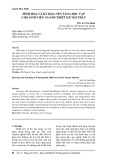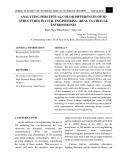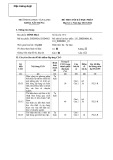
Transport and Communications Science Journal, Vol 76, Issue 01 (01/2025), 1-15
1
Transport and Communications Science Journal
OPTIMISING TORQUE FOR THREE-DISC AFPMSM IN
ELECTRIC VEHICLES USING BP_ANN AND ANFIS
ALGORITHMS
Nguyen Van Hai, Vo Thanh Ha*
University of Transport and Communications, No 3 Cau Giay Street, Hanoi, Vietnam
ARTICLE INFO
TYPE: Research Article
Received: 28/11/2024
Revised: 05/12/2024
Accepted: 10/01/2025
Published online: 15/01/2025
https://doi.org/10.47869/tcsj.76.1.1
* Corresponding author
Email: vothanhha.ktd@utc.edu.vn
Abstract: Designing an optimal torque distribution controller for the three-disc axial flux
permanent magnet synchronous (three-disc AFPMSM) optimises performance while ensuring
robustness, stability, and adaptability in a real-world condition. This is crucial for maximising
the potential of AFPMSM, particularly in a modern application like an electric vehicle and a
renewable energy. Thus, a controller compatible with more complex systems in the future is
essential. This paper presents a system that combines torque control algorithms based on a
back-propagation neural network (BP-ANN) and an Adaptive Neuro-Fuzzy Inference System
(ANFIS). The BP-ANN uses a multi-layer structure where the input layer processes factors
such as load torque, rotational speed, and stator current, hidden layers model complex
nonlinear interactions, and the output layer predicts optimal torque for AFPMSM operation.
Training involves minimising the error between predicted and actual torque through gradient
descent and iterative adjustments of weights and biases. The ANFIS-based control enhances
performance by integrating neural network learning with fuzzy logic to optimise torque
output. By leveraging the strengths of both BP-ANN and ANFIS, the system offers a stable,
efficient, and adaptable solution for three-disc AFPMSMs. The Matlab/Simulink simulations
confirm its effectiveness, showing balanced torque distribution, reduced energy losses,
improved drivetrain efficiency, and adaptability to sudden load or road changes, ensuring
stability and enhanced dynamic response.
Keywords: Three-Disc AFPMSM Motors, AFPMSM, BP-ANN, ANFIS.
@ 2025 University of Transport and Communications

Transport and Communications Science Journal, Vol 76, Issue 01 (01/2025), 1-15
2
1. INTRODUCTION
Axial flux permanent magnet synchronous motors (AFPMSMs) are now preferred in
electric vehicles for improved torque, reduced pulsation, and higher efficiency [1]. Multi-disc
AFPMSMs are ideal for heavy-duty vehicles like buses and trucks due to their compact
design, high torque and power density, energy efficiency, durability, and integration potential.
By optimising coil and magnet arrangement, AFPMSMs achieve greater power density than
radial flux motors, especially in multi-disc designs [2]. These offer high torque, benefiting
vehicles needing strong starting and acceleration performance [3]. Their compact design suits
integrated systems, combining motor, drive, and controller while saving space and boosting
performance over wide speed ranges [4]. The thermal management of AFPMSMs contributes
to their reliability and operational longevity. Advanced cooling techniques, such as liquid
cooling systems integrated directly into the motor structure, efficiently dissipate heat,
ensuring performance stability under high loads and extended operational periods [5]. This
feature makes them particularly advantageous for applications in heavy-duty vehicles, which
often operate under strenuous conditions.
The three-disc AFPMSM has a complex magnetic field, making it challenging to model
factors like saturation, loss, and temperature effects [6]. Optimising its energy efficiency is
urgent yet tricky. To tackle these challenges, researchers are exploring hybrid modelling
techniques that combine finite element analysis (FEA) with analytical methods to capture
better the intricacies of the three-disc AFPMSM's magnetic behaviour [7]. These approaches
aim to improve accuracy in predicting performance parameters, enabling more precise control
strategies [8]. In addition, advanced control methods like DTC or MPC enhance torque
management and energy efficiency, meeting complex demands and enabling quick responses
[9]. However, multi-disc AFPMSMs face design challenges due to complex magnetic fields
and require precise control for optimal torque distribution. Developing accurate mathematical
models and advanced integrated control systems remains a focus for researchers [10].
Intelligent control methods, multi-objective optimisation, and precise modelling are essential.
Control strategies like ANN, FLC, and ANFIS excel in managing the motor’s nonlinear traits
without needing an exact model [11]. FLC uses experience-based rules to adjust torque for
unstable systems, which is ideal for dynamic conditions like electric buses, though it may lack
precision under extreme fluctuations [12]. Combining FLC with MPC or ANN improves
stability [13]. ANN learns from data to optimise motor torque distribution and maintain
efficiency in complex systems, but it requires extensive data, high computational power, and
increased costs [14]. Based on the literature [15], sliding mode control (SMC) is based on
defining a sliding surface and controlling to keep the system's state always on that surface.
This control method can self-adjust when the system is subjected to disturbances or load
changes. Therefore, this control method effectively reduces the effects of disturbances and
sudden load changes. SMC can respond quickly, helping the electric bus operate stably when
facing unexpected situations. In addition, SMC can cause chattering in the control signal,
requiring additional techniques to minimise this effect. In addition, PID controllers are
optimised using intelligent algorithms. These smart algorithms use optimisation algorithms
such as Genetic Algorithm (GA) or Particle Swarm Optimization (PSO) to optimise the
parameters of the PID controller to find the optimal PID parameters for torque control. GA-
PID and PSO-PID can find the best control parameters for various operating conditions,
resulting in efficient torque regulation and increased responsiveness. On the downside, the
optimisation process can be time-consuming and only sometimes responds well to conditions

Transport and Communications Science Journal, Vol 76, Issue 01 (01/2025), 1-15
3
that change too quickly or have high nonlinearity [16]. The ANFIS algorithm combines
artificial neural networks and fuzzy logic to learn control rules from training data,
automatically adjusting torque based on actual operating conditions. The ANFIS algorithm
has good learning and adaptability, allowing flexible torque adjustment based on changes in
load and speed conditions. ANFIS is suitable for electric buses because it can learn and adapt
in real time. However, ANFIS requires a large amount of data for training and a long
calculation time, mainly when operating conditions change rapidly [17]. This paper describes
the integrated design of a torque distribution control system for three-disc AFPMSMs. The
Backpropagation Neural Network (BP-ANN) optimises the torque for each AFPMSM motor,
while the ANFIS algorithm manages the torque of a three-disc AFPMSM based on current
conditions. During vehicle operation, the controller processes sensor inputs about the vehicle's
status and torque requirements. The system continuously monitors and automatically adjusts
the torque in real time, ensuring stable and efficient engine performance under various
conditions, such as acceleration.
The paper is organised into five parts. Part 1 highlights the need to enhance motor
efficiency for industrial demands, focusing on torque control of the AFPMSM three-disc
motor as the solution. Part 2 presents the motor's mathematical model, covering its structure,
flux, and dynamic equations, with parameters determined through analysis and experiments.
Part 3 introduces a control strategy combining neural networks with the ANFIS method to
improve accuracy, reduce computation time, and enhance efficiency. Part 4 validates the
approach using MATLAB simulations, while Part 5 summarises the findings, suggests AI
enhancements, and outlines future research directions.
2. A THREE-DISC AFPMSM MATHEMATICAL MODEL
The stator windings of this motor are chosen to capture the three-stator, double-rotor
AFPMSM operation accurate. This facilitates the development of a mathematical model that
closely resembles the conventional model used for PMSMs. The mathematical model
developed for the three-disc AFPMSM is expressed within the framework of the three-phase
stationary coordinate system, which provides a consistent basis for understanding its
performance and integrating it with existing systems and technologies [10].
The equation for calculating voltage is as Eq. (1) [10]
(1)
Eq. (2) defines the magnetic flux [10]:
1
1111 111
1
1111 1111
2
2222 222
2
2222 2222
3
3333 333
3
3333 3333
d
dsdd qq
t
q
qsqq dd
t
d
dsdd qq
t
q
qsqq dd
t
d
dsdd qq
t
q
qsqq dd
t
di
uRiL Li
d
di
uRiL Li
d
di
uRiL Li
d
di
uRiL Li
d
di
uRiL Li
d
di
uRiL Li
d
w
wwy
w
wwy
w
wwy
ì=+ -
ï
ï
ï=+ + +
ï
ï
ï
=+ -
ï
ï
í
ï=+ + +
ï
ï
=+ -
=+ + +
î
ï
ï
ï
ï
ï

Transport and Communications Science Journal, Vol 76, Issue 01 (01/2025), 1-15
4
(2)
The three-disc AFPMSM torque is calculated using the following Eq. (3) [10]:
(3)
The torque of the three-disc AFPMSM is rewritten according to the following Eq. (4) [10]:
(4)
In equations (1)–(4) , , are three stator resistors and, respectively ,
, , , , are d-q axis components of the winding voltage vector of stator 1, stator
two and stator 3. , , , , , as shaft component d-q of the coil current vector of
stator 1, stator two, and 3. , , , , , are the d-q axial components of the coil
inductance of stator 1, stator two and stator 3. , , , , , are the d-q axis
components of the coil flux of stator 1, stator two và stator three. , và are the
electromagnetic moment of the stator 1, stator two và stator 3. , and is the load
moment of stator 1, stator 2 and stator 3. J is the moment of inertia, and B is the viscosity
coefficient and load torque. Since two stators share the same rotor, it can be roughly
considered that when two motor modules are coaxially connected, it is possible to obtain
. Since the three stators drive the same two rotors, the two rotors are
coaxially connected to the three stators, so the three-disc AFPMSM is structurally equivalent
to three single-stage AFPMSMs coaxially connected. Thus, the reference coordinate systems
correspond to three identical stators. The motors corresponding to the three stators can be
analysed using the same d-q reference coordinate system. Since the three stators are
structurally symmetrical, so we have . Besides, the three-disc AFPMSM has
a uniform air gap .
The moment mathematical equation can be rewritten as follows [10]:
(5)
111
111
222
222
333
333
ddd
qqq
ddd
qqq
ddd
qqq
Li
Li
Li
Li
Li
Li
yy
y
yy
y
yy
y
=+
ì
ï=
ï
ï=+
ï
í=
ï
ï=+
ï=
ï
î
111111
222222
333333
3()
2
3()
2
3()
2
mqdqdq
mqdqdq
mqdqdq
TpiLLii
TpiLLii
TpiLLii
y
y
y
ìéù
=+-
ëû
ï
ï
ïéù
=+-
íëû
ï
ïéù
=+-
ïëû
î
1
11 1
2
22 2
3
33 3
mL
t
mL
t
mL
t
d
j
TTB pd
d
j
TTB pd
d
j
TTB pd
w
w
w
w
w
w
ì-- =
ï
ï
ï
ï-- =
í
ï
ï-- =
ï
ï
î
1s
R
2s
R
3s
R
1d
u
1q
u
2d
u
2q
u
3d
u
3q
u
1d
i
1q
i
2d
i
2q
i
3d
i
3q
i
1d
L
1q
L
2d
L
2q
L
3d
L
3q
L
1d
y
1q
y
2d
y
2q
y
3d
y
3q
y
1m
T
2m
T
3m
T
1L
T
2L
T
3L
T
123rr r r
ww ww
===
123ss s s
RR R R== =
123qq q q
LL L L== =
123 123
3()
2
mm m m p qq q
TT T T Nfi i i
y
=+ + = ++

Transport and Communications Science Journal, Vol 76, Issue 01 (01/2025), 1-15
5
Where: is the total electromagnetic torque of the motor , , and is the
electromagnetic moment of stators 1, 2 and 3. The coils are a component of stator coil
current vectors 1, 2 and 3 in the q-axis.
3. TORQUE CONTROL STRUCTURE FOR A THREE-DISC AFPMSM
3.1. Torque control structure
Figure 1 shows the interconnection structure of a three-disc AFPMSM drive system.
This system features three independent stator windings, requiring three motor controllers.
Conventional electric vehicle controllers can improve the system's efficiency through
communication management. The first vehicle controller sends commands to the
communication management unit, which assesses the motors' operating states and torque
intensity according to predefined control strategies and distributes control signals and torque
data to the three motor modules [10].
Figure 2 shows the core of the control strategy: torque estimation, distribution, and
feedback. These elements boost efficiency, reliability, and adaptability by accurately
estimating demand, allocating torque, and optimising performance in real-time [10].
Figure 1. The interconnection structure of a three-disc AFPMSM [10].
m
T
1m
T
2m
T
3m
T
3q
i






![Kỹ năng diễn họa ý tưởng: Quy trình thiết kế nội thất [Chuẩn nhất]](https://cdn.tailieu.vn/images/document/thumbnail/2025/20250123/tuetuebinhan000/135x160/2951737633170.jpg)











![Bài giảng Quản lý vận hành và bảo trì công trình xây dựng [chuẩn nhất]](https://cdn.tailieu.vn/images/document/thumbnail/2025/20251006/agonars97/135x160/30881759736164.jpg)







